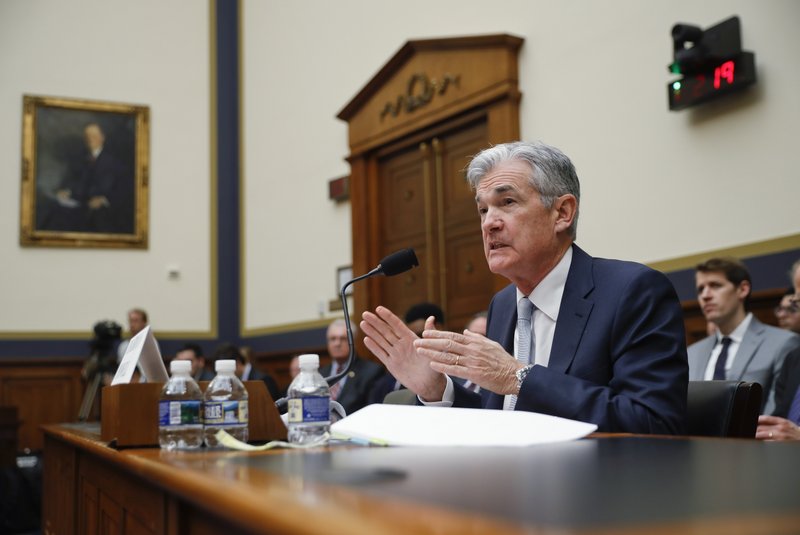WASHINGTON -- The Federal Reserve is expected to leave its key short-term interest rate unchanged today and to stress its new watchword -- "patient"-- in conveying its intention to leave rates alone for the foreseeable future.
The Fed has made clear that with a dimmer economic picture in both the United States and globally, it no longer sees the need to keep raising rates as it did four times in 2018. Among the key factors, besides slower growth, are President Donald Trump's trade war with China, continually low inflation levels and Prime Minister Theresa May's struggle to execute Britain's exit from the European Union.
Still, some analysts say, the Fed will want to avoid escalating public concerns about the health of the economic expansion, the second-longest on record.
"They don't want to be too alarming," said Diane Swonk, chief economist at Grant Thornton. "Much of this weakness is likely to be transitory."
Besides issuing a policy statement today, the Fed will update its forecasts for the economy and interest rates, and Chairman Jerome Powell will hold a news conference. Analysts will be looking for any fresh hints of how the Fed intends to manage its rate policies in the coming months.
The Fed is expected to leave its benchmark rate -- which can influence everything from mortgages to credit cards to home equity lines of credit -- unchanged in a range of 2.25 percent to 2.5 percent.
Economists surveyed by Bloomberg expect just one hike this year, in September, at which point the tightening cycle will have peaked.
Analysts will also be watching the so-called "dot plot." This is an illustration in which each of the 17 members of the Fed's interest rate committee provides his or her anonymous forecast of where their key policy rate will go. Today, the dots will show where the officials expect the rate to be at the end of 2019 and after each of the next two years. The median dot -- where half are above, half below -- is closely watched for the Fed's view of where its key rate might be headed.
It isn't always accurate. In December 2017, for example, the Fed's policymakers predicted four rate increases in 2018. That proved true. In September 2018, though, the Fed projected three rate increases this year, only to reduce that prediction in December to two. And for today, many economists say they think the new dot plot will forecast just one rate increase this year.
Even that may overstate what the Fed will end up doing. Traders in futures markets have put the probability of a rate increase at any time this year at zero percent, according to data tracked by the CME Group. In fact, the CME index projects a one-in-four chance that the Fed will go so far as to cut rates by year's end to help fight an expected economic slowdown.
Some analysts say the chairman may use today's news conference to explain the changed outlook since September.
"I believe Powell will want to provide a justification of why the Fed has done a 180-degree turn in the last few months," said Sung Won Sohn, chief economist at SS Economics.
One of the extraordinary programs the Fed deployed after the 2008 financial crisis to stabilize the economy was the purchase of billions in Treasury and mortgage bonds. The idea was that these bond purchases would help hold down long-term borrowing rates and thereby stimulate borrowing and spending.
It was called quantitative easing. And while it likely helped revive the economy, it also ended up swelling the Fed's balance sheet more than four-fold, from under $1 trillion to a peak of $4.5 trillion. In October 2017, with the economy back on firm footing, the Fed began shrinking its portfolio by allowing some maturing bonds to roll off its balance sheet rather than being reinvested. As a result, the balance sheet is now down slightly to $4 trillion.
As this runoff from the Fed's balance sheet has proceeded, investors have grown worried that the Fed could overdo the bond reductions and inadvertently cause long-term rates to surge. That would risk depressing economic growth as well as stock prices.
When Powell suggested at a news conference in December that the runoff from the Fed's balance sheet was on "automatic pilot," he alarmed investors, who began dumping stocks. Powell has since reversed course. He has increasingly stressed the Fed's patience and flexibility toward all elements of its policy making, from its benchmark rate to the runoff from its balance sheet, depending on how severe the economic risks appear. And the chairman has said that the reduction in its bond holdings will end soon, with a balance sheet probably no lower than around $3.5 trillion.
In recent appearances, Powell has said the Fed has been discussing a plan to end the runoff from its balance sheet. Many analysts think the Fed will specify today at what point this year it plans to halt the reduction in its bond holdings -- something of keen interest to financial markets.
Information for this article was contributed by Jeanna Smialek of Bloomberg News.
Business on 03/20/2019
